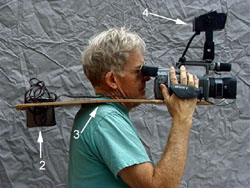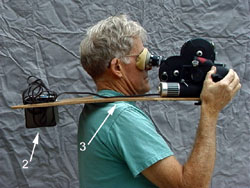The Horse Collar
Here is a low-tech application of
some of the principles of inertial stabilization. A "J" shaped piece of plywood
(1) about the operatorís neck can hold the camera right in front of the face
and can be counter-balanced by batteries (2) on the bottom left side of the
board opposite the camera behind the operator. The center of gravity (CG) should
be at the support points, the operatorís shoulders (3). Make the plywood larger
than you think and cut away what you don't need after you place the battery
hole. Mark the plywood where your shoulders touch the plywood and then balance
the camera about this point with the position of the battery. Cut a hole for
the battery that is a snug fit. Thin aluminum works well for a battery "bucket".
If the rig will be used with different cameras or with and without a light (4),
you might make a long battery trough that will allow the battery to move back
and forth for weight and CG adjustment over the shoulder. Remember that you
have an extension behind you when shooting around people and don't hit them
when you turn your body.
This rig works very well in small
boats and bouncing vehicles when the operator is securely seated. The operator's
body acts as a million-dollar feedback stabilization system IF the weight is
supported by his shoulders and guided by his arms. Guiding it closer to the
support points, the shoulders, works best. In the picture I am holding it for
focus and zoom control. It also works well for long shooting times, tele shots
and gives the ability to move to a new position easily. If you don't have a
periscope or tilting viewfinder on your camera, you can raise to camera to eye
height with a block of wood. A threaded 1/4"20 or 3/8"-16 stud with two nuts
will make a bolt to fit enough threads in the bottom of the camera and not "bottom".
Washers help make bolt length adjustments too.
Isolating the walking motions of
the operator from the camera is more difficult. The camera has to be better
isolated from the operator's body. Practice helps a lot, small steps and wearing
low profile shoes helps, such as moccasins. Moccasins are not good for the feet
with an extra load on them. Try arch supports.
© Copyright 1999-2004 Ron Dexter. All Rights Reserved.







